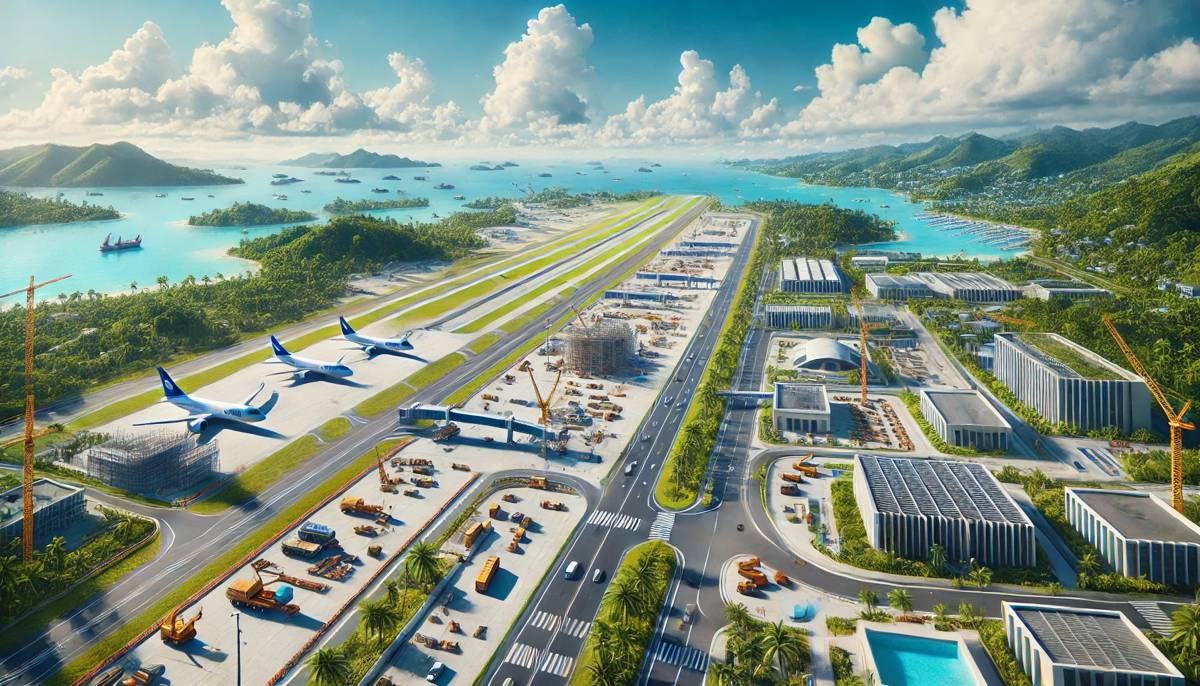Fiji set to transform Nadi International Airport into a World-Class Hub
Nadi International Airport, the gateway to Fiji and a vital link for the South Pacific, is set to undergo a major transformation.
The 2024 Masterplan, unveiled by the Fijian government, outlines an ambitious vision to modernise the airport and position it as a leading aviation hub in the region. With significant upgrades planned to address existing capacity constraints and enhance the airport’s functionality, this development is more than an infrastructure upgrade—it’s a strategic move to boost Fiji’s economic prospects and strengthen its role in global aviation.
Addressing Capacity and Efficiency
Nadi International Airport, located just 5 kilometres from Nadi town on the western side of Viti Levu, is Fiji’s busiest airport and the main point of entry for international travellers. As passenger numbers and air traffic continue to grow, the airport faces critical capacity challenges that could impede its future potential. The 2024 Masterplan aims to address these issues head-on, implementing a phased approach to development that balances immediate needs with long-term growth objectives.
One of the primary areas of focus is the airport’s runway and taxiway infrastructure. Currently, the airport struggles with limited parallel taxiways, which restrict terminal access and increase runway occupancy times, leading to delays. The addition of new parallel taxiways is a priority, as it will enhance overall airfield capacity and streamline aircraft movements.
Runway limitations are also a significant concern. Runway 09/27, a key operational asset, is neither long nor robust enough to handle aircraft larger than Code C. This forces all larger aircraft to use Runway 02/20, creating a bottleneck that hampers operational efficiency. Furthermore, the existing 180-metre strip width of Runway 09/27 falls short of International Civil Aviation Organization (ICAO) standards for 3C and 4C aircraft, necessitating urgent structural upgrades to bring it up to compliance.
In addition to runway enhancements, the Masterplan highlights the need for more aircraft parking stands to accommodate the anticipated increase in air traffic. As passenger and cargo volumes rise, the availability of parking stands will become increasingly critical to the airport’s operations, driving the need for expanded infrastructure.
Expanding Terminal Capacity
Terminal capacity is another pressing issue addressed in the Masterplan. Various sections of the airport, including the Domestic Terminal, International Departures, Baggage Handling System, and Baggage Reclaim areas, are already operating at or near capacity. To keep pace with projected passenger growth, terminal space will need to expand significantly—from the current 27,500 square metres to approximately 75,850 square metres by 2043.
These upgrades are not just about adding more space; they’re about enhancing the passenger experience. By redesigning key terminal areas, the airport aims to improve passenger flow, reduce congestion, and provide a more seamless journey from check-in to boarding. Enhancements will also include modernising the baggage handling system to improve efficiency and minimise delays, a crucial aspect of maintaining the airport’s reputation as a premier gateway.
Additionally, the Masterplan calls for the redevelopment of outdated cargo and freight facilities, which are undersized and nearing the end of their asset life. These facilities, located adjacent to the terminal, not only occupy valuable real estate but also contribute to increased road congestion. The proposed relocation and modernisation of cargo operations will not only improve logistics but also free up prime space for passenger-focused developments.
Commercial and Mixed-Use Developments
Beyond the runways and terminals, the Masterplan envisions a series of commercial and mixed-use developments that will redefine the airport’s role as an economic engine for Fiji. One of the standout projects is the proposed terminal infill development at the Nadi Terminal Carpark, which will incorporate a transit hotel and mixed-use retail spaces. This development aims to enhance passenger amenities while generating new revenue streams, capitalising on the airport’s strategic location.
The plan also includes the creation of commercial and mixed-use precincts within the Fiji Airports Compound. These precincts are set to cater to the growing demand for office, retail, and hospitality spaces near the airport, turning the surrounding area into a vibrant commercial hub that complements the airport’s operations. By integrating these developments, the airport isn’t just expanding its capacity—it’s transforming into a multifunctional destination that supports business, leisure, and aviation activities.
An Aviation Training and Development Precinct is also a key component of the Masterplan. Linked to the Fiji Airways Aviation Academy and the Fiji Airports Aviation Academy, this precinct aims to position Nadi as a regional centre for aviation training, attracting students and professionals from across the Pacific. This initiative underscores Fiji’s broader ambition to become a leader in aviation education, adding another layer to the airport’s evolving identity.
Infrastructure Upgrades and New Facilities
To support the airport’s expanded role, the Masterplan outlines several critical infrastructure upgrades and new facilities. A new administrative building will centralise the airport’s management functions, streamlining operations and improving efficiency. The development also includes the construction of two train maintenance workshops and a cargo transfer centre in La Dorada, further enhancing the airport’s logistical capabilities.
Flood prevention measures are also a crucial part of the project, with 1,480 hydraulic works planned to mitigate flood risks along the corridor. This is vital for maintaining operational continuity during adverse weather conditions, ensuring that the airport remains resilient in the face of climate-related challenges.
Driving Growth and Connectivity
The expansion of Nadi International Airport is more than just an infrastructure project—it’s a strategic investment in Fiji’s future. By addressing existing capacity constraints and preparing for long-term growth, the Masterplan aims to position Nadi as a key aviation hub in the Pacific, boosting connectivity and driving economic development.
Enhanced airport infrastructure is expected to attract more international flights, stimulating tourism growth and creating thousands of new jobs. The expansion will also improve cargo handling capabilities, making Fiji a more attractive destination for freight operations and supporting the broader economy by facilitating smoother trade and logistics.
The development will help reduce road congestion around the airport, improve passenger flow, and create a more seamless travel experience. With Fiji’s tourism industry rebounding strongly post-pandemic, these enhancements are not just timely—they’re essential for maintaining the country’s competitive edge in the global travel market.
A New Era for Nadi International Airport
As Nadi International Airport embarks on this transformative journey, the focus remains on creating a world-class facility that not only meets current demands but also anticipates the needs of the future. The phased approach of the 2024 Masterplan provides a clear blueprint for growth, balancing immediate infrastructure upgrades with strategic long-term investments.
The expansion of Nadi International Airport is set to redefine Fiji’s aviation landscape, positioning it as a premier gateway to the Pacific. For the region, this development represents a new era of connectivity, opportunity, and economic prosperity—one where Nadi stands at the forefront of aviation excellence.




















